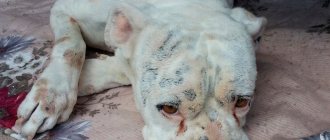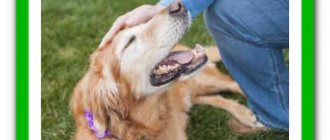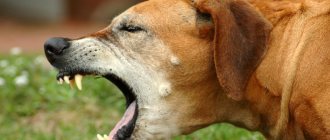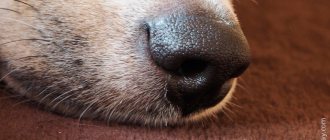Shortness of breath in a dog is an alarming symptom if the causes are not physiological. Treatment of pathology is carried out strictly by a doctor. The veterinarian will tell you how to help your pet and identify the disease that caused this syndrome.
Some types of shortness of breath are not a deviation and, after a short time, the animal’s breathing returns to normal. However, disturbances in inhalation and exhalation at rest may indicate serious problems. In such cases, immediate help is required; at home, you can only take the first steps until the veterinarian arrives.
What is shortness of breath, its types
Dyspnea is a condition in which a pet has an irregular breathing rhythm. This is a protective physiological reaction to oxygen starvation. With a lack of gas exchange processes in tissues, irritation of the respiratory center in the brain occurs. The body tries to restore balance by increasing breathing speed or increasing the depth of inhalation and exhalation.
According to its origin, the condition is divided into:
- Physiological. Occurs after an active walk, physical activity (running, playing), during the hot season. Shortness of breath is a normal condition for brachycephalic dogs. Due to the anatomical features of the structure of the skull, breathing in pets of these breeds throughout their lives is significantly different from other animals. The physiological type of the condition resolves without the use of any additional procedures.
- Pathological shortness of breath is a consequence of the disease or an accompanying syndrome and can occur in a dog in a calm state.
The pathological variety is divided into:
- Tachypnea - respiratory movements are rapid, inhalation and exhalation are shortened.
- Bradypnea - breathing becomes rare, the inhalation may be short, but a heavy exhalation is observed.
- Apnea is a pathological condition in which there is no breathing movement.
Depending on the nature of inhalation and exhalation, the following are conventionally distinguished:
- inspiration, when the pet has difficulty breathing;
- expiration - difficulty exhaling;
- mixed type, when there is difficulty in inhaling and exhaling.
Clinical picture and diagnostic methods
A dog's breathing is assessed by inspection, palpation, and auscultation. In rare cases, special diagnostic tools are used. During the study, the frequency, rhythm and symmetry of respiratory movements are noted.
The number of respiratory movements per minute depends on the age, breed, weight of the animal, physiological or pathological condition. For medium-sized dog breeds, the breathing rate is 14-25 movements per minute. Large dogs breathe less frequently, and in small breeds the frequency can reach 30-40.
Factors influencing increased breathing:
- age – puppies always breathe more often due to their high metabolism;
- gender – rates are higher in females, especially during pregnancy;
- size, weight and constitution;
- temperature – dogs cool themselves by breathing;
- stress – tachypnea in dogs develops after training.
A dog's rapid breathing can be shallow or deep. The causes of rapid shallow breathing are associated with fever, inflammation of the lung tissue or bronchi, and pulmonary edema. The pathology is associated with the body’s protective reaction when the alveoli are stretched - shallow breathing avoids secondary stretching of the lung tissue. If the dog is breathing rapidly and deeply, then one should assume the presence of oxygen deficiency (carbon monoxide poisoning), severe stress, or a stressful situation.
Breathing may become rare. This occurs when the respiratory centers are depressed due to brain damage or poisoning. A severe weakening of respiratory function occurs in the near-death state.
An examination (rhinoscopy) of the upper respiratory tract is required to identify foreign bodies and other causes obstructing the passage of air.
Dyspnea is any difficulty breathing that leads to a pathological rhythm. Dyspnea is divided into inspiratory (on inspiration), expiratory (on exhalation) and mixed, manifesting itself in both phases. Dyspnea leads to oxygen starvation - at the beginning of the disease, the dog can compensate for the pathology by increasing breathing speed, but gradually the carbon dioxide content in the blood increases, cyanosis of the mucous membranes, restless behavior, and hyperhidrosis appear.
Shortness of breath clinic:
- the head and neck are extended;
- the front paws are spaced far apart;
- the mouth is open, the nostrils are wide;
- expiratory dyspnea is manifested by double exhalation;
- The abdominal cavity is involved in the act of breathing.
More often than others, a mixed form of shortness of breath is recorded, which occurs with various pathologies of the respiratory system, heart and brain. At rest, the disease may not manifest itself, but after physical exertion, dogs suffocate. Sharp suffocation occurs with spasms of the upper respiratory tract.
Breathing rhythm disturbance
In a normal state, the phases of inhalation and exhalation occur in a certain sequence with equal intervals of time between them. Inhalation is normally shorter than exhalation. In various pathological conditions, changes in rhythm occur.
Stokes breathing:
- prolonged cessation of breathing (up to 30-50 seconds);
- the act of breathing gradually increases and then weakens;
- develops with hemorrhages in the brain, toxicosis.
When rhythm disturbances of the Biot type are observed in dogs, a number of deep respiratory movements are noted. Then there is a short pause and the rhythm is repeated again. It is a sign of brain diseases (trauma, tumors), intoxications.
In the dying state, animals exhibit Kussmaul respiration. It is characterized by rare deep breaths. They are repeated without a certain rhythm and are interrupted by large phases of apnea. It is observed in dogs with distemper.
Intermittent breathing is observed in diseases of the respiratory organs - bronchitis, pneumonia, emphysema, pleurisy. This form is characterized by small pauses during breathing. It can also be observed in dogs in a normal state during stressful situations.
Causes of shortness of breath in dogs
There are many reasons for breathing problems. Most often, shortness of breath occurs due to:
- Heart diseases and circulatory disorders.
- Respiratory diseases (viral infections, injuries, respiratory disorders, inflammatory processes).
- Pathologies of the central nervous system (tumors, injuries, hematomas, cysts, etc.).
- Metabolic disorders.
- Diabetes.
- Severe poisoning with poisons and toxins.
- Kidney failure.
- Helminthiasis (dirofilariasis).
- As a complication after illness (for example, after piroplasmosis, anemia persists, this leads to oxygen starvation in all tissues).
- Obesity.
- Stress. Due to the production of hormones that increase the contractility of the heart muscle and increase the speed of blood flow, which leads to an attack of shortness of breath from overexcitation in the pet.
The main types and causes of cough in dogs
The cough reflex is protective in nature. Its main purpose is to cleanse the upper respiratory tract of germs, foreign objects, purulent secretions, mucus or other irritants.
Cough as a symptom may indicate the development of completely different diseases. It is necessary to note all the little things that can be noticed in the dog’s well-being. When visiting a doctor, only with the help of a full story from the owner will a specialist be able to collect a primary anamnesis. It is necessary to describe the duration, timbre, strength of cough, time of manifestation and other additional clinical manifestations.
Now let's talk about the main reasons in more detail.
Pneumonia
Pneumonia refers to inflammation of the lung tissue. There are several types of the disease, which depend on the etiology. The main types include: viral, bacterial, fungal, parasitic and aspiration pneumonia. The last one is the most dangerous.
Most often, the disease develops as a complication. In rare cases, the disease manifests itself:
- Unsatisfactory animal maintenance;
- Unbalanced diet;
- Sudden changes in temperature;
- Insufficient drying of the pet's fur after bathing;
- Mechanical injuries of the sternum;
- Inhalation of chemicals that cause lung burns;
- Pulmonary edema.
Main clinical manifestations:
- Cough is the main symptom of respiratory system dysfunction;
- Fever indicates an increase in body temperature;
- Intoxication of the body increases, fatigue, apathy, and refusal to eat develop;
- Dyspnea;
- Difficulty breathing;
- Vomiting reflex;
- Tachycardia.
Therapeutic measures are aimed at combating the infectious agent - eliminating the cause and improving the general condition of the body.
After conducting a set of diagnostic studies, the doctor prescribes appropriate treatment. In case of bacterial contamination, antibiotics will be needed, which are selected taking into account the sensitivity of microorganisms. It is often necessary to combine two drugs that complement each other’s actions. It is not recommended to select medications on your own.
Symptomatic treatment aimed at improving the general condition of the animal is of no small importance. Drugs that reduce fever, painkillers, immunomodulators, vitamin and mineral complexes are used. “Neglected” patients are recommended to be treated in a hospital. They are given medications intravenously along with drips.
Cordial
Cough often accompanies heart failure. The heart increases in size and puts pressure on the trachea, causing a cough reflex.
Distinctive characteristics:
- Deaf;
- Dry, without phlegm;
- Painful, prolonged attacks;
- Reduced performance;
- Shortness of breath, apathy.
Dilated cardiomyopathy is a disease characterized by dilation of the heart cavities. This is one of the reasons for the development of cardiac cough. The main function of the body's main muscle is to pump blood. When this function is impaired, deficiency develops. German Spitz dogs with cardiomyopathy grunt, wheeze, and cough. The disease is treatable only in the early stages.
Parasitic
The risk of parasite infection increases in dogs that live for a long time in unsanitary conditions and without proper treatments. The main types of endoparasites that affect the respiratory organs are toxacara and hookworm.
A dog becomes infected by swallowing an adult helminth or its larval form. Inside the body, parasites migrate with the bloodstream, reaching their destination – the lung tissue. Tracheobronchitis develops, causing paroxysmal coughing.
Modern doctors talk about the peak incidence of dirofilariasis in dogs. Infection occurs through a mosquito bite. The lungs and cardiac system are affected. A moderately wet cough develops, worsening when lying down.
Treatment boils down to deworming and increasing the body's defenses.
Allergic
An allergic cough is accompanied by sneezing, cyanosis of the mucous membranes, copious discharge from the eyes, and skin rashes. The reason is contact with an allergen. This could be food, plants, chemicals or parasite treatments.
Therapeutic measures are aimed at eliminating the allergen and improving the general condition of the animal.
Oncological
One of the clearest symptoms of lung cancer is a persistent cough. Sputum contains dead tissue cells. There is difficulty breathing, shortness of breath, and fatigue. Adenocarcinoma is the most common disease among dogs. Cancers are difficult to treat and often result in death. Maintenance therapy is reduced to the use of drugs that dilate the bronchi and relieve spasms.
Entry of foreign bodies
The entry of a foreign object into the respiratory tract is a consequence of impaired swallowing. This occurs when the central nervous system is disrupted, for example, with rabies, or when eating food quickly. A foreign object entering the respiratory tract or lungs causes an inflammatory process. The animal begins to cough, often with bloody sputum. The attacks are accompanied by suffocation and wheezing; they occur periodically and often lead to vomiting.
The only correct solution if a foreign body gets into the respiratory tract is to urgently consult a doctor so that he can remove the object using an endoscopic device.
The surgery is performed in a veterinary clinic under general anesthesia. Further treatment consists of the use of antibiotics to help relieve the inflammatory process.
Tracheal collapse
Miniature Spitz dogs are more susceptible to tracheal collapse. The disease is difficult to completely cure, but it can be controlled. The disease is inherited and is associated with flattening of the tracheal rings. Instead of being O-shaped, they are C-shaped. The rigidity of the rings decreases, the friction of the posterior and lower walls of the trachea increases, which causes coughing. The attacks are accompanied by suffocation and wheezing.
The doctor makes the diagnosis based on radiography.
Symptoms of the disease
The pathology is manifested by frequent, jerky breaths with an open mouth. When shortness of breath is also observed:
- fainting and loss of consciousness;
- cyanosis of visible mucous membranes;
- cough;
- vomiting;
- wheezing, whistling when breathing.
Expert opinion
Kuzmenko Olga Olegovna
Information about the expert
Ask a Question
Cardiac dyspnea occurs when walking, while the dog often sits or lies down, tries to catch its breath, and coughs. The pet practically cannot run.
How can I determine the source of the problem?
Diagnosis of pathology is possible only after a comprehensive examination of the pet, which includes:
- General examination of the animal, auscultation, palpation.
- X-ray examination of the lungs and heart.
- ECG, echocardiogram.
- Ultrasound examination of the abdominal organs.
- General clinical and biochemical blood tests.
- Detection of viral and bacterial diseases (intestinal and respiratory infections).
The physiological type of respiratory rhythm disorder can be determined at home by carefully monitoring the pet. If the condition appears after a walk or physical activity, the dog should recover within 20-40 minutes.
First aid for shortness of breath in a dog
When help can be provided at home:
- If a dog’s shortness of breath occurs due to flatulence, the pet is provided with a starvation diet and given sorbents (Enterosgel, Polysorb) 3-4 times a day. If you experience diarrhea, vomiting, or increased body temperature, you should consult a doctor.
- If shortness of breath develops when the air temperature rises, the pet is provided with a bath in cool water. At the same time, be sure to cool the paws, ears and occipital area (between the ears). The animal is given complete rest, plenty of fluids to drink and physical activity is limited.
- After a walk and physical activity, the pet is allowed to rest. Feeding is allowed after complete restoration of breathing.
- In stressful situations, the animal is given sedatives (Fitex, Gabapentin, Stop-Stress, etc.).
Cases in which you should immediately consult a doctor:
- The animal's oral mucosa turned blue.
- Breathing rhythm disturbances and coughing are observed even in a calm state.
- The animal is depressed, breathing in and out is difficult, the pet cannot lie down.
- It is not normal to experience breathing problems after surgery and may indicate pulmonary edema or cardiac dysfunction.
First aid that can be provided before the veterinarian arrives:
- In the room where the dog is, provide good ventilation: open the windows, turn on the humidifier, and air conditioning.
- Rub the animal's back, ears and chest with light movements.
- If your dog has severe shortness of breath, you can give a few drops of Corvalol (can be applied to the tongue, or diluted in a small amount of water and administered orally with a syringe without a needle).
Difficulty breathing: possible causes
The owner of the animal should be wary if a failure in breathing occurs suddenly. There can be a variety of reasons why your dog may begin to choke, including:
- getting a foreign object into the breathing tube, which can be practically any little thing, for example, buttons, threads, parts of a children's construction set;
- during a walk, large plant seeds may get into your pet’s inquisitive nose;
- swelling of the larynx as a result of an infectious disease or an allergic reaction to medications or insect bites.
In addition, the causes of difficulty breathing in a dog may be heart problems - myocardial disease or cardiovascular failure, which are accompanied by blue mucous membranes, heavy breathing, and decreased physical activity. It is possible that there are parasites in the body - roundworms that live in the heart muscle or pulmonary arteries.
The animal may also experience seizures caused by:
- stress as a result of strong emotional shock, for example, an unfamiliar place, public transport, gunshots or fireworks, even a visit to the veterinary clinic;
- chest injury or hydrothorax - accumulation of fluid in the chest cavity;
- neoplasms, polyps in the nasopharynx, which provoke coughing and shortness of breath;
- pain in the abdominal cavity, increased gas formation.
Further treatment
When treating shortness of breath in a dog, the most important thing is to establish the true cause of the development of this condition. Therapy will be aimed at stopping the underlying disease.
Animals in serious condition are placed in an oxygen chamber, and vital signs (body temperature, pulse, respiratory rate) are constantly measured. Depending on the pet’s condition, intensive therapy is carried out, adjusting prescriptions according to the situation.
The following groups of drugs are used:
- corticosteroids;
- cardiac glycosides;
- diuretics;
- antibiotics (if necessary);
- saline solutions (in the form of intravenous infusions).
Prevention measures
- Vaccinate your pet against viral infections in a timely manner.
- In hot weather, do not physically burden the dog. In summer, walks are carried out early in the morning and late in the evening, when the peak heat has subsided.
- If your pet has chronic diseases, be sure to show the animal to the veterinarian once a year (even if there are no complaints about the general condition).
- Once every 4 months, carry out deworming and treatment against ectoparasites.
- Dogs of brachycephalic breeds should be under especially careful supervision of the owner. Any concomitant respiratory pathology will negatively affect breathing patterns.
The appearance of shortness of breath in a dog requires special attention, since the condition may be a sign of a serious illness. In case of repeated cases of difficulty breathing in a pet, it is important to immediately carry out diagnostics and measures to relieve the pathology. At home, first aid can only be provided before the veterinarian arrives; self-treatment is highly discouraged.
First aid technique for a dog if it is choking
When a dog chokes on food, the first thing to do is calm down and not panic. First, assess your pet's condition. If his tongue turns blue and breathing is difficult, then urgent veterinary help is needed. You cannot force your dog to drink vegetable oil, because the pet’s swallowing reflex may be impaired due to a foreign body. There are special techniques that will help him, but if possible, it is still better to take your four-legged friend to the veterinarian.
If it is not possible to contact a specialist, you need to help the dog cough up a foreign object. For large and small dogs, the assistance technique will be slightly different.
Big dog
If the dog is wheezing or coughing, then stand slightly behind the dog. Bend over and wrap your arms around your pet's body where the chest meets the stomach. Place the fist of your right hand under the sternum in the area where it meets the stomach. With your other hand, grab the elbow or wrist of your right hand so that both hands fit snugly against the animal's body. Then you need to forcefully squeeze the pet’s body forward and upward.
Repeat the compression until the dog coughs up the foreign object. After this, it would not hurt to remove the foreign body from the mouth so that the pet does not choke on the bone again. Usually 3-6 pressures are enough for the dog to cough up the bone or food. If you have repeated the movements 10 times already, but there is no result, then urgently call a veterinarian at home.
Little dog
If a small dog is choking, then it needs to be placed on your lap and pressed with its back to your chest. Place the fist of your right hand at the junction of the sternum and the stomach, and it is advisable to hold your head with your left hand. Push sharply forward and upward with your fist several times. Also, after coughing up an object, it is advisable to remove it from the pet’s mouth.











